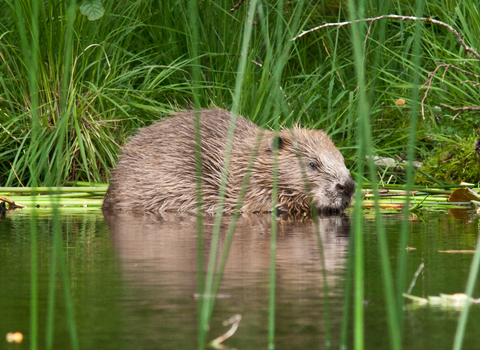
Beaver ©Nick Upton
©David Parkyn
Beaver ©David Parkyn
Beaver ©David Parkyn
Beaver
Beavers are the engineers of the animal world, creating wetlands where wildlife can thrive. After a 400-year absence, beavers are back in Britain!
Scientific name
Castor fiberWhen to see
Beavers are most active and visible during dusk and dawn. Its easiest to capture a good sighting of a beaver during the spring and summer months when they emerge before darkness falls.Species information
Statistics
Length: 70-100cmTail: 30-40cm
Weight: 18-30kg
Average lifespan: 10+ years
Beavers are being re-introduced into different parts of Great Britain after an absence of about 400 years.
Habitats
About
Beavers are Britain’s largest rodent, the group of mammals that includes rats, mice, and voles. They live in freshwater habitats, like rivers and streams, and prefer areas surrounded by wetland plants, trees and woodland. They are rather slow on land but excellent swimmers, so they feel safest when they’re close to deep water (around 70cm deep). If the water isn’t deep enough for them, beavers can make it deeper. They use mud, wood, and stones to build dams across shallow rivers, streams and ditches. The dams are leaky and let some water through, but slow down the flow enough for ponds to form, where the beavers can live and feel secure.Beavers often shelter in burrows dug into a riverbank, with an underwater entrance tunnel. Some of these can be enlarged into bank lodges. If the bank isn’t suitable for a burrow, they can build a lodge from woody debris, twigs and soil. The lodge could be on a riverbank, or out in the middle of a beaver-built pond. A lodge offers a safe place to eat, sleep and raise young.
Beavers live in small family groups, formed by a pair of adults and any young they’ve had that year, and sometimes the young from the previous year, too. Pairs usually stay together for life. Breeding takes place between December and April and the pregnancy lasts for 103-108 days. Females give birth to their litter of 1-6 young in early summer (the average litter is 2-3 young). The young, called kits, reach sexual maturity at two years old, but don’t tend to breed successfully until they’re at least three.
Beavers are herbivores, feeding entirely on plants. In summer, they prefer pond weeds, grasses, leaves and other parts of plants. In winter they eat the bark of trees, favoring willow, poplars and alder. They have iron in the enamel on their teeth, which gives them extra strength for gnawing through wood, as well as making them a distinctive orange colour. They are crepuscular, meaning they are most active at dawn and dusk.
Beavers will also create a food cache in autumn in preparation for winter, to ensure they have enough to eat over the colder months. A food cache consists of branches and twigs, which are stored underwater by pushing them into the floor at the bottom of the waterbody, close to the entrance of their lodge.
Beavers are known as a keystone species – a species that plays a critical role in creating thriving ecosystems from which a wealth of wildlife benefits. By creating dams, making ponds, and forming canals to swim around their territory, beavers create habitat that helps lots of other wildlife to thrive, including water beetles, birds, bats, frogs, and fish. Their dams can also prevent flooding further down the river, keep water flowing during droughts, and even filter the water passing through them.
Beavers were once found throughout Britain, but were hunted to extinction in the 16th century for their fur, meat, and the oil in their scent glands, which was used in medicine and even perfumes. But now beavers are back! Thanks to the work of The Wildlife Trusts and other conservation charities, they have been reintroduced to Scotland. Many Wildlife Trusts are also running projects with enclosed beavers on nature reserves in England and Wales, with the ambition that one day beavers will be widespread in the wild once more.
How to identify
Beavers are large rodents, about the size of a tubby spaniel, with a stocky body and short legs. They have a broad, flat scaley tail, as well as strongly webbed hind feet. Their dense fur (the second most dense in the animal kingdom) is usually brown but can sometimes be black. They have small eyes and large, bright orange front teeth.In the water, beavers could be confused with otters. However, otters are much more sleek in appearance and have long, rounded tails covered in fur.
Distribution
Beavers have been reintroduced to the wild in Scotland, where they have been granted legal protected species status. There are also wild populations in England and Wales, as well as many enclosed beaver populations on nature reserves.The Eurasian beaver has a global distribution extending from Britain across most of Europe and into Asia.
In our area
Beavers have been extinct in Shropshire for over 400 years, but could one day make a return. From Autumn 2022, beavers will be a fully protected species thanks to new legislation passed in July 2022.
Did you know?
Beavers can swim at speeds of up to five miles per hour and hold their breath for up to 15 minutes. They even have a pair of swimming goggles – extra eyelids (called nictitating membranes) that are transparent, which they can close when they’re underwater.Beavers have been extinct in Shropshire for over 400 years, but could one day make a return. From Autumn 2022, beavers will be a fully protected species thanks to new legislation passed in July 2022.

